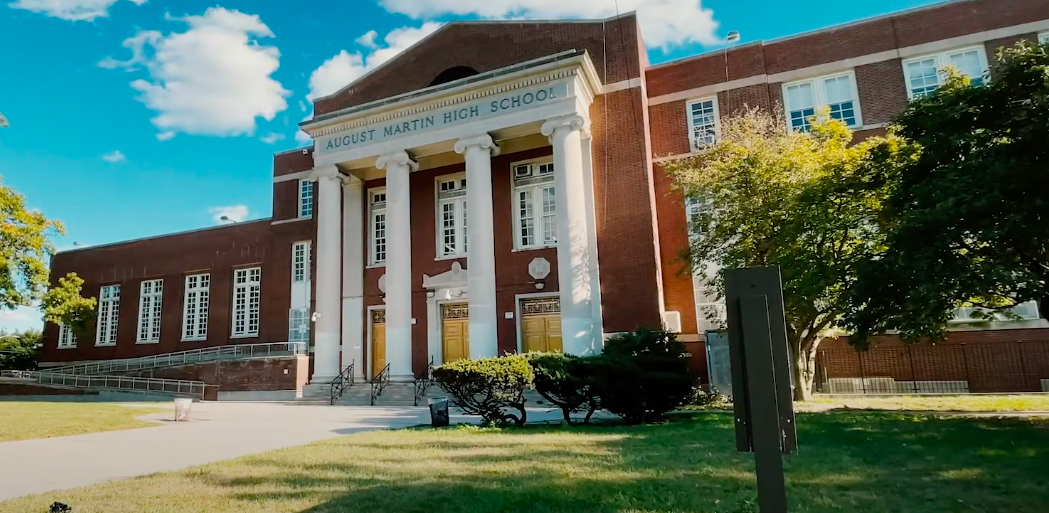
Support Queens Community House
Queens Community House provides individuals and families with the tools to enrich their lives and build healthy, inclusive communities.

ChalkbeatNY: Enrollment at NYC’s transfer high schools tanked during the pandemic. Can it rebound? | May 2023: Alyssa Cartagena stopped attending school after giving birth a year ago. She had no babysitter, and going back felt insurmountable.
But a small alternative high school on Manhattan’s Upper West Side helped pull her back in. The program, Edward A. Reynolds West Side High School, boasts an on-site day care center operated by the education department. She enrolled her two-month old son, Shawn, dropping him off each day before heading to class.
“I was nervous, but I was also relaxed knowing I was so close to him, and I can stop by anytime,” said Cartagena, now 19. “It was easier for me to focus in class.”
She’s now on track to earn a high school diploma later this year.
The city has nearly 60 transfer schools like West Side that focus on the students who struggled to succeed at traditional high schools and are at risk of dropping out. They pride themselves on offering individual support, small classes, and a suite of wraparound services to push students to graduation.
But the city’s transfer schools are in a precarious position, as enrollment across the sector has plummeted. The number of students attending transfer high schools fell 22% over the past four years compared with a 5% decline at traditional high schools, a Chalkbeat analysis found. Steep dips in enrollment can put schools in danger of being closed or merged.
Already, the education department has put forward a contentious plan for West Side, which shrank from serving about 500 students six years ago to about 200 this year. The proposal calls for West Side to swap buildings with The Young Women’s Leadership School in East Harlem, which is outgrowing its campus.
Community members have blasted the proposal because it would leave West Side without an on-site child care center or health clinic. Some have also warned students may face threats to their physical safety if they cross neighborhood lines.
The education department has argued the move, along with a new Spanish dual-language program, could help attract new students to West Side. After the department delayed the proposal earlier this month, the city’s Panel for Educational Policy is scheduled for a Monday vote that will be closely watched.
The battle playing out at West Side only represents the most high-profile example of the transfer school enrollment crisis that has been simmering below the surface. About 70% of the city’s transfer schools now enroll fewer than 200 students, up from about 26% in 2017. A handful have slipped below 100.
The enrollment drops are likely due in part to more relaxed academic standards at traditional high schools during the pandemic, observers say. Some of the sector’s leaders believe it will bounce back as regular grading policies — and state graduation exams — fall back into place.
But dwindling enrollment raises questions about the sustainability of a network of schools that exclusively serve students who are at risk of dropping out, including those who have been tangled in the criminal justice system, face difficult family circumstances, or may be parents themselves. Since schools are funded largely based on enrollment, shrinking rosters can make it difficult to offer a wide range of classes and extracurricular activities.
Education department officials did not respond to questions for this story, including whether they are considering merging or closing transfer schools.
Some leaders across the sector believe that enrollment will rebound, but there is lingering concern that a broader wave of restructuring could be on the horizon.
“It might have to be the reality — I don’t know that you can run a school with 100 students,” said one transfer school principal who spoke on condition of anonymity for fear of retribution.
“We’ve been sort of warned, in a sense: Keep your numbers up or that’s something that could happen.”
Why is transfer school enrollment dropping precipitously?
Transfer school leaders trace the steep decline in enrollment to pandemic-era policies that made it easier for students to stay on track at traditional high schools.
When the pandemic forced campuses to shut down in 2020, schools eased their grading policies. And state officials temporarily paused the Regents exams, typically required for graduation. Students only had to pass their courses to graduate rather than sit for an additional state exam.
Students may have been able to pass classes they would have failed in a typical year, said Jai Nanda, executive director of Urban Dove, which operates two charter transfer schools, one in Brooklyn and one in the Bronx.
Traditional high schools had incentives to hang on to more of their students, since many of those campuses were also experiencing enrollment declines. Plus, families may simply have been more reluctant to switch schools during such a chaotic time, even if a student was struggling.
“[Students] chalked it up to being remote rather than their school not being a good fit for them,” Nanda said.
Transfer schools may also have lost students who became disconnected from school due to growing mental health and anxiety problems, or because they needed to work to support their families. Some may have moved out of the city with their families because of rising housing costs.
Small-by-design schools are more vulnerable to enrollment drops
Whatever the cause, declining enrollment has an outsized effect on transfer schools, which are typically smaller to begin with to offer more individualized support than a traditional campus.
Shawn Henry, a director of high school programming at Queens Community House, helps oversee the organization’s partnership with three transfer high schools. The group ensures every student is paired with a counselor, conducts home visits if a student doesn’t show up for three consecutive days, and helps coordinate paid internship opportunities.
“The ideal model is a smaller environment,” Henry said.
But that size makes it difficult to absorb big enrollment swings — though so far the schools have been insulated by an influx of federal relief money.
At Urban Dove, which has seen enrollment dip, the school has a heavy focus on sports, with all students expected to participate on athletic teams with coaches who work with them multiple hours each day. “A great deal of that program is beyond the traditional school budget,” Nanda said. Emergency pandemic aid kept the program afloat.
Click here for the full article.